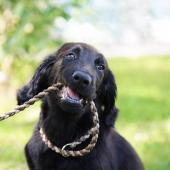In the breeding database, you can find both information on individual dogs and statistics on the health and breeding of different breeds.
On the dog's own page you can view the pedigree, inbreeding rate, health, show and test results, breeding indices and information about siblings and possible offspring. You can compare how the inbreeding rate changes when calculated with different generations. In the case of already deceased dogs, you can see the date and cause of death if the owner of the dog has provided this information for use in the breeding database.
The dog's own page also shows its offspring as well as statistics on the official health survey results of the offspring. In the user settings, you can set which information about dogs for each breed is displayed in the listings and pedigrees. You can find these settings in the link list at the top of the page: Other breed related: Settings
Breed related statistics on health, character and tests
Breed related statistics include breed health, breeding and result statistics. You can see the annual statistics for the time period of your choice since 1988, and you can, for example, look at whether progress has been made in breeding, i.e. whether the proportion of healthy dogs has increased over the years.
The health statistics include all the research results that are officially recorded for the breed, as well as the statistics on the cause of death. From the breeding statistics you can see the annual registration numbers of the breed, litter sizes, the number and average age of the sires and dams, as well as the annual and generational figures on the population's gene pool and genetic variation. From the breeding statistics, you can also list the most popular breeding dogs with their number of offspring and their offspring statistics. From the offspring statistics, you can see, for example, the proportion of the dog's studied offspring and how much of the studied offspring have been healthy.
The results statistics include the results of character tests as well as mental descriptions, various dog tests and agility.
In addition to ready-made statistics, you can use an advanced search where you can set different search criteria for the dogs' year of birth, sex, number of offspring, health and test results, and BLUP index.
The breeding database is internationally unique
Due to its openness and scope, the Finnish Kennel Club's breeding database is also unique internationally. In other Nordic countries, dog data is also stored in extensive databases, but only in Finland and Sweden are databases openly accessible to anyone. In the Finnish Kennel Club's breeding database, the data have also been collected into statistics that are as useful and illustrative as possible. In these statistics, you can find a great deal of information about the genetic diversity and health of different breeds.







 Hau-Hau Champion
Hau-Hau Champion Agria
Agria